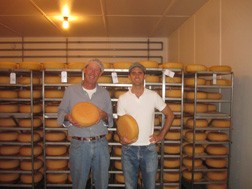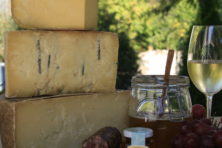The Cheese Insider
- Share
- Tweet
- Pin
- Share
One of my favorite styles of cheeses is commonly known as “Alpine Style.” This family of cheeses originated in the Alps of Switzerland and eastern France. The remote villages of this mountainous region had very little tillable land in the valleys, but did have lush alpine meadows, and an abundant fresh water supply, perfect for grazing cows in the summer months.

The herdsman/cheesemakers take the cows into the mountains and make cheese in the summer, and in the fall they bring the cows and the cheese they have been making all summer back down the mountains for the winter.
Well known examples of this style of cheese are Emmental (Swiss), Gruyere, Appenzeller and Beaufort. Alpine cheeses are typically hard, rinded, with a nutty flavor. This style of cheese is more durable and could endure the long trips out of the mountains in the fall.
The high quality Alpine-style cheeses made here in Wisconsin include Pleasant Ridge Reserve of Uplands Cheese in Dodgeville, Emmental (big wheel Swiss) of Edelweiss Creamery in Monticello, and Alpine Renegade from Bleu Mont Dairy in Blue Mounds.
All three of these cheeses are made with grass-fed cow milk in the tradition of European Alpine-style cheesemaking.
Andy Hatch, the head cheesemaker at Uplands Cheese, was the featured guest at a recent “Meet the Cheesemaker” event at The Savory Spoon Cooking School in Ellison Bay. Andy shared his stories about what goes into making Pleasant Ridge Reserve, the most celebrated cheese made in America.
It starts with the farm, 300 acres, located in the driftless region of southwest Wisconsin. This part of Wisconsin was not touched by the last glaciers that rolled through Wisconsin, leaving rolling hills and beautiful topsoil.
The farm practices what is known as “rotational grazing.” The cows are moved from one pasture to another every day, ensuring a fresh food supply and eliminating the need to spread manure the way farmers with barn cows have to do. The 160 cows in the herd at Uplands are made up of six different breeds, generally a bit smaller than the black and white Holsteins that are so common here in Wisconsin.
The cows that produce the fine Alpine cheeses in Europe are generally smaller and a bit more athletic, bred to walk up and down the steep hills of the Alps. The milk produced by this herd is one of the things that make their cheese so unique. The cheese is made only when the pastures produce enough for the cows to eat. Once the fields dry up they stop making cheese, and sell the milk to outside sources. Once the milk is turned into cheese the work just begins.
The wheels of cheese are rubbed by hand with salt and washed with brine every day for the first 30 days of curing. Then it is every other day that the wheels are washed by hand with natural bacteria, creating a rind on the surface of the cheese. This rind is what protects the cheese and allows it to age for up to 18-24 months. Throughout the aging process one wheel from every batch, approximately 70 wheels made daily, is used to test the cheese. Andy will take core samples, using a device called a tryer, from the wheel to determine how the cheese is aging, and the flavor profiles he is looking for.
Each day that Uplands makes cheese the milk is slightly different from the day before, because the cows are in a different pasture, and are subject to different weather conditions.
Our cheesemongers get asked all the time…”what makes it an “artisan” cheese? The skill, hard work, and careful planning in making a cheese like Pleasant Ridge Reserve is a good example to share with our customers.
Come into one of our shops, and try some of the best artisan cheese found anywhere, especially Pleasant Ridge Reserve, and the other “Alpine “cheeses we offer…you will be glad you did.



